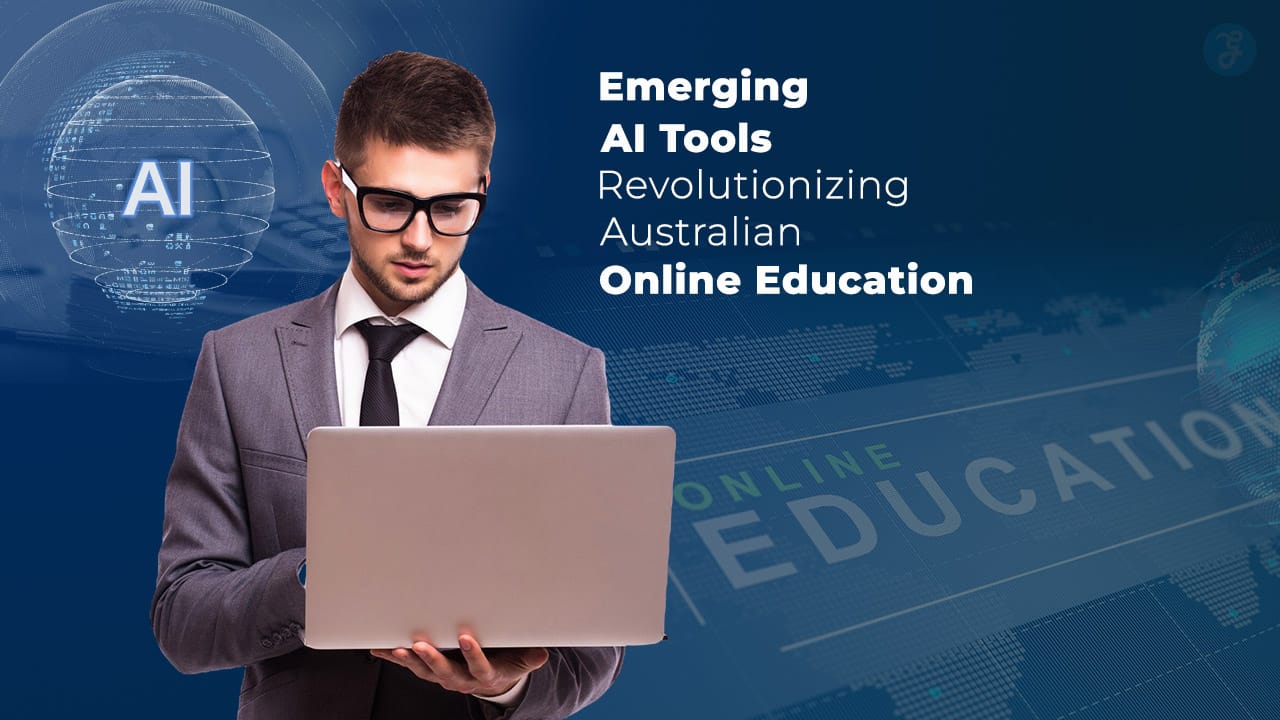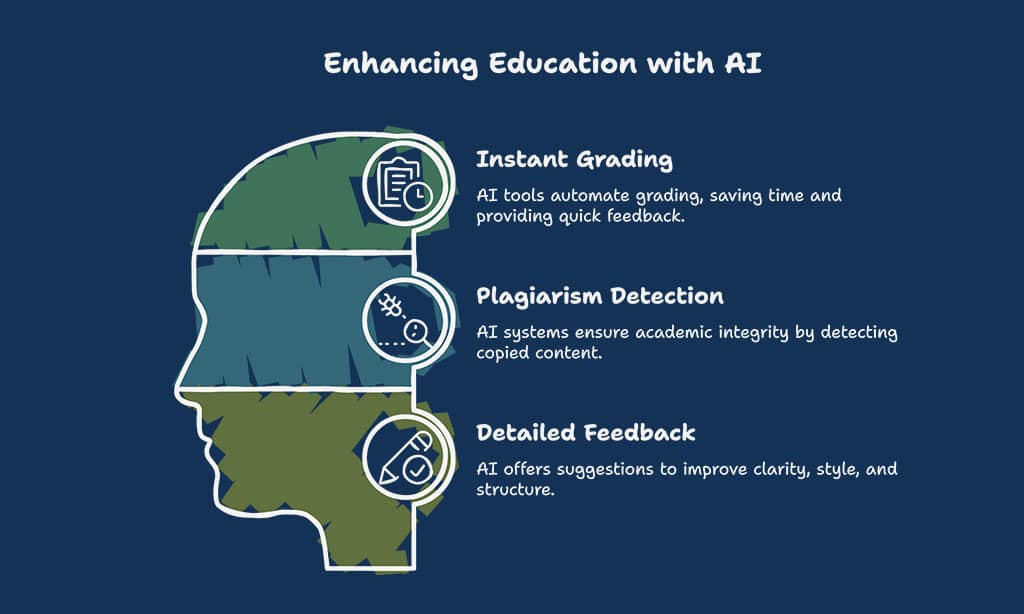The evolution of education technology has led to a paradigm shift in how learning is delivered, particularly in the online space. In Australia, where online education has become a critical component of the national learning system, Artificial Intelligence (AI) is at the forefront of driving innovation.
AI tools are reshaping the learning landscape, making education more personalized, engaging, and effective for students, while also reducing the burden on educators.
This article delves into the 7 emerging AI tools revolutionizing Australian online education, providing insights into how each of these tools is transforming the sector.
From intelligent tutoring systems to adaptive learning platforms, we will explore their features, benefits, and real-world applications, while also including current data to illustrate their growing importance.
The Rise of AI in Online Education in Australia
Australia’s education system has seen significant advancements in technology over the last decade. The rise of AI is particularly noteworthy, as it offers solutions that enhance the online learning experience for both educators and students.
AI tools can be employed to automate tedious administrative tasks, personalize learning content, and provide real-time feedback on assignments, resulting in a more efficient and interactive learning environment.
Why AI is a Game-Changer for Online Education
AI’s biggest advantage in education lies in its ability to personalize learning. Every student learns at their own pace and has their own unique strengths and weaknesses. AI tools can tailor content to match these individual learning profiles, ensuring that students receive the support they need at just the right time.
For instance, AI algorithms can suggest specific lessons, assignments, or study materials based on a student’s previous performance, helping them progress faster and more effectively.
Additionally, AI can provide real-time feedback that would be impossible for human instructors to deliver consistently, allowing students to adjust their learning strategies immediately.
AI also helps to streamline administrative processes, freeing educators from time-consuming tasks like grading and record-keeping, and enabling them to spend more time teaching.
The Growth of AI Tools in the Australian Education Sector
AI adoption in Australia’s education sector is accelerating. According to recent statistics, over 50% of Australian universities have incorporated AI-powered tools into their teaching and learning strategies.
These tools are not limited to just large universities; AI applications are also being adopted in K-12 schools and technical colleges across the country, benefiting a wide range of students.
Key Trends in AI Integration into Online Education in Australia:
- Personalized Learning: AI tools are tailoring educational content to fit the needs and learning speeds of individual students, improving retention and engagement.
- Automation of Administrative Tasks: AI is automating routine administrative tasks such as grading, attendance tracking, and scheduling, allowing educators to focus on teaching.
- AI-Powered Tutoring: AI tutoring systems are providing students with personalized learning experiences outside of regular class hours.
- Data-Driven Insights: AI helps educators make data-driven decisions, improving their teaching strategies and boosting student performance.
7 AI Tools Revolutionizing Australian Online Education
AI tools are transforming Australian online education by enhancing learning outcomes, improving engagement, and providing more efficient solutions for students and educators. Let’s take a deeper dive into 7 emerging AI tools that are revolutionizing the education landscape.
1. AI-Based Learning Platforms
AI-based learning platforms like Coursera and Udemy have transformed the way students access educational resources. These platforms use AI algorithms to personalize learning experiences by recommending courses and content based on students’ previous activities, preferences, and progress.
This ensures that students receive tailored learning paths that align with their interests, allowing them to stay engaged and motivated.
The AI capabilities of these platforms extend beyond just recommending courses. These platforms track the learning journey of each student and use data-driven insights to modify the difficulty level and format of learning materials, helping students progress at their own pace.
Key Features:
- Adaptive Course Recommendations: AI analyzes the student’s past behavior to recommend relevant courses, ensuring a personalized learning experience.
- Real-Time Feedback: Instant assessments of students’ performance provide actionable insights to improve learning outcomes.
- Interactive Learning Modules: AI enhances engagement by providing interactive content such as quizzes, multimedia resources, and discussion forums.
Comparison of Traditional Learning Platforms vs AI-Powered Platforms
| Feature | Traditional Learning | AI-Powered Learning |
| Course Recommendations | Based on course categories | Personalized based on learner’s history |
| Feedback | Delayed, often manual | Real-time, automated |
| Learning Pace | Fixed | Adaptive to each student’s pace |
| Engagement | Static, lecture-based | Interactive, with multimedia |
By offering tailored courses, interactive features, and real-time feedback, AI-based learning platforms offer a highly engaging and personalized learning experience for students across Australia.
2. Intelligent Tutoring Systems
Squirrel AI is an example of an AI-powered intelligent tutoring system that uses machine learning to offer personalized tutoring for students. These AI-driven systems can identify students’ strengths and weaknesses in real time and automatically adjust the course material to match their individual needs.
This technology has made personalized education more accessible, providing students with round-the-clock tutoring support outside of classroom hours.
Intelligent tutoring systems go beyond automated content delivery; they offer adaptive learning experiences that ensure students understand concepts at their own pace, with detailed explanations and additional resources provided when necessary.
Key Benefits of Intelligent Tutoring Systems
| Benefit | Description |
| Real-Time Personalized Feedback | AI systems track a student’s progress and adapt lessons based on performance, providing immediate support. |
| Individualized Instruction | Students receive one-on-one tutoring that is tailored to their unique learning style and pace. |
| Continuous Assessment | AI tutors assess students continuously, ensuring they are consistently on track and offering timely interventions when needed. |
List: Key Features of Intelligent Tutoring Systems
- Adaptive content based on student’s knowledge level
- Personalized feedback and lesson adjustment
- Available 24/7 for students in need of extra assistance
- Comprehensive tracking of student progress
3. AI-Powered Virtual Classrooms
Platforms like Classcraft and Open edX are incorporating AI to create more immersive and engaging virtual classrooms. These AI-powered platforms manage classroom activities, track student participation, and analyze performance to ensure students stay engaged.
AI can also help educators identify when students are disengaging or struggling with the material, allowing them to intervene before problems escalate.
Additionally, AI in virtual classrooms supports gamified learning elements, making the educational experience more fun and motivating for students. Gamification, through AI, helps to reinforce learning by rewarding students for progress and achievement.
Key Features of AI-Powered Virtual Classrooms
| Feature | Description |
| Automated Attendance and Participation Tracking | AI automatically records attendance and tracks student participation in virtual class discussions. |
| Gamification | AI integrates interactive and engaging activities, increasing student participation and motivation. |
| Real-Time Engagement Analytics | AI analyzes students’ engagement levels in real-time, allowing educators to adjust teaching strategies based on insights. |
List: Key Benefits of AI-Powered Virtual Classrooms
- Increased engagement through gamification and interactive activities
- Real-time feedback on student performance
- Streamlined classroom management
4. Natural Language Processing (NLP) for Assessment
AI tools using Natural Language Processing (NLP), such as Grammarly and Turnitin, help automate the assessment process, offering quick and accurate feedback. NLP tools are particularly useful for analyzing written content, identifying grammatical errors, detecting plagiarism, and providing suggestions for improving writing.
NLP-powered assessment tools help students improve their writing skills by providing actionable feedback that goes beyond simple grammar corrections.
These systems can analyze sentence structure, clarity, and even the tone of the writing, offering valuable insights to students seeking to enhance their communication skills.
Key Benefits:
- Instant Grading: AI tools grade written content automatically, saving educators time and offering students quick feedback.
- Plagiarism Detection: AI-powered systems can detect copied content, ensuring academic integrity.
- Detailed Feedback: AI offers suggestions on improving clarity, style, and structure in written assignments.
Examples of NLP Tools in Education
| Tool | Function | Key Features |
| Grammarly | Grammar and spelling check | Instant feedback on writing, style suggestions |
| Turnitin | Plagiarism detection | Comprehensive originality report, citation assistance |
| QuillBot | Sentence rephrasing | Paraphrasing, vocabulary enhancement |
5. AI Chatbots for Student Support
AI-powered chatbots, such as Ada and Botsify, are making student support more efficient by automating responses to common queries. These chatbots are available 24/7 and can handle inquiries related to course enrollment, deadlines, exam schedules, and general academic guidance.
By automating student support, educational institutions can ensure that students receive timely assistance without overloading staff.
Key Features and Uses of AI Chatbots in Education
| Key Feature | Description |
| Instant Response | AI chatbots provide immediate answers to students’ questions, ensuring no student has to wait for support. |
| Personalized Interaction | Chatbots can tailor responses based on student profiles and preferences. |
| 24/7 Availability | Students can access support at any time of day, from any location. |
List: Key Uses of AI Chatbots in Education
- Answering course-related questions
- Providing administrative support for enrollment and scheduling
- Sending reminders for assignments and deadlines
6. AI for Adaptive Learning and Personalized Content
Tools like Knewton and DreamBox use AI to deliver adaptive learning, tailoring educational content based on each student’s progress. These platforms adjust the difficulty of lessons and offer additional resources when a student is struggling with a particular topic.
By personalizing the learning experience, these tools ensure that students remain engaged and motivated, while also allowing them to move at their own pace.
Key Benefits:
- Dynamic Content Delivery: AI adjusts content in real-time, based on the student’s progress.
- Continuous Learning: Students are provided with appropriate challenges to avoid frustration or boredom.
- Data-Driven Personalization: AI tools use data to continually personalize learning, ensuring the content matches the student’s needs.
Comparison of Traditional vs Adaptive Learning
| Feature | Traditional Learning | Adaptive Learning |
| Pace | Fixed | Flexible, adaptive |
| Difficulty Level | Static | Adjusts dynamically |
| Content Delivery | Uniform for all students | Tailored to each student |
| Support | Limited | On-demand support |
7. AI-Driven Data Analytics for Student Progress Tracking
AI-powered data analytics tools, like Civitas Learning and Blackboard Analytics, track student performance and provide actionable insights for educators. These tools can identify students at risk of falling behind, predict future performance, and suggest targeted interventions.
By analyzing vast amounts of data, these AI tools offer a more accurate, comprehensive picture of student progress than traditional methods.
Key Benefits:
- Predictive Analytics: AI tools predict student outcomes based on historical data, allowing for early interventions.
- Improved Decision-Making: Educators can make informed decisions based on data-driven insights, improving their teaching strategies.
- Student Retention: By identifying at-risk students early, AI tools can help institutions implement strategies to improve retention rates.
Pointer: How Data Analytics is Shaping Education
- Real-time tracking of student progress
- Proactive intervention strategies for struggling students
- Data-informed decisions to enhance teaching and learning
Comparison of Traditional Learning Platforms vs AI-Powered Platforms
| Feature | Traditional Learning | AI-Powered Learning |
| Course Recommendations | Based on course categories | Personalized based on learner’s history |
| Feedback | Delayed, often manual | Real-time, automated |
| Learning Pace | Fixed | Adaptive to each student’s pace |
| Engagement | Static, lecture-based | Interactive, with multimedia |
The Impact of AI Tools on the Future of Online Education in Australia
AI tools are reshaping not only the present state of online education but also paving the way for future advancements. As the use of AI grows, the potential for revolutionizing personalized learning, improving teaching efficiency, and increasing access to education expands exponentially.
By leveraging AI, Australian educators can provide a more interactive and individualized experience for students, resulting in better outcomes for all involved.
Takeaways
The 7 emerging AI tools revolutionizing Australian online education are fundamentally changing the way students learn, interact with content, and receive support. AI is not just enhancing the current educational systems but is also setting the stage for a future where learning is more personalized, accessible, and efficient than ever before.
As AI tools continue to evolve, they will offer even more sophisticated solutions to enhance the educational experience, benefiting students, teachers, and institutions across Australia.
Embracing these technologies is crucial for both educational institutions and learners who want to stay ahead in a rapidly changing digital world.












































